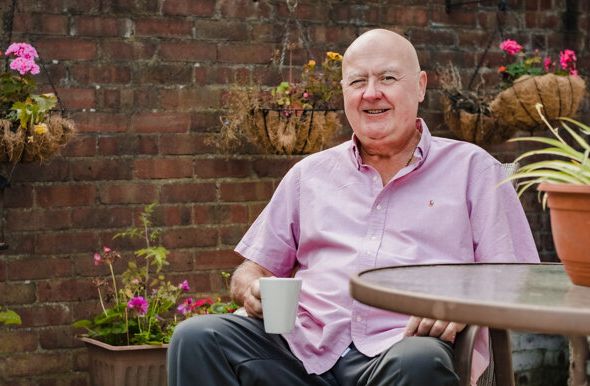
A taxi driver from Romford, Essex, has spoken about his experience of receiving blood plasma after contracting Covid-19.
John Curtis, 58, came down with the virus not long after lockdown. He’d gone back to work, but developed a dry cough shortly after. Initially, he put it down to the air conditioning in his car but it worsened, so he went to a drive-through Covid-19 testing facility and his results came back positive.
“The next day I woke up and felt like I’d run a marathon up and down the stairs,” he says. “I phoned 111 and had to break off from talking to get my breath. They sent an ambulance and I was taken into the Queen’s Hospital in Romford.
“I felt frustrated I hadn’t got things sorted properly for my kids. I felt like I could walk out alive or get carried out.”
On the ward, Curtis was told he could join a trial to try one of three different treatments – one of which was convalescent plasma.
This type of treatment involves plasma being collected from donors who have recovered from Covid-19, via their blood. The plasma contains antibodies that help the body fight against the virus.
When the antibody-rich plasma is transfused into newly-infected patients, it’s thought it gives their immune systems a fighting chance in staving off the worst repercussions of infection.
“I said I will take part in anything to try and combat this thing,” says Curtis. “I had to sign a form and they came around with the plasma.
“It was like a bag of orange fluid, about half a litre. I had one unit a day for two days. It went through me in about half an hour.”
Did it work?
The father-of-two is still recovering from Covid-19, but believes the plasma has had some impact. “I like to think it helped, though the trial is still going on,” he says. “My son is a doctor with some experience of it and he thinks it helped.
“I did speculate a bit about who donated but at the end of the day it’s another human being. I am planning to donate next month after I feel better than I do now. I hope to help someone myself.”
There is promising evidence for the effectiveness of convalescent plasma but before general use, patient benefit needs to be demonstrated in randomised control trials.
Researchers previously told HuffPost UK they anticipate results from the plasma trial in the last quarter of 2020.
More donations are needed
With Covid cases rising in the UK, NHS Blood and Transplant said it urgently needs more people who’ve had Covid-19 to donate convalescent plasma, as transfusions reached a new high during September.
Around 220 or more people received convalescent plasma for medical trials this month, which is the highest monthly figure since the first plasma transfusions in May. It’s also more than four times the number of plasma recipients during August.
NHSBT holds around 6,000 units of donated convalescent plasma with high enough antibody levels for the trials. A further 2,000 units have been issued to hospitals and have either been transfused or are in local storage.
Donations are needed, though, so that if the trial confirms patient benefit, stocks can be made available for general use.
“Our stocks are good but it will only stay that way if people keep donating.”
- Sheila MacLennan, NHSBT transfusion consultant and clinical lead for the Convalescent Plasma Programme
Sheila MacLennan, NHSBT transfusion consultant and clinical lead for the Convalescent Plasma Programme, said: “Our stocks are good but it will only stay that way if people keep donating. We especially need men to donate as they are more likely to have high enough antibody levels for the trial.”
The increase in demand is believed to be partly a result of the national rise in coronavirus cases, but also because more hospitals are taking part in plasma trials.
Professor Jonathan Van-Tam, the deputy chief medical officer for England, urged people to do two things: consider volunteering for clinical trials if you get Covid-19 – “these are the only way to obtain really high quality evidence about what works and what doesn’t,” he says – and to donate plasma if you’ve previously had the virus.
“We need to build up the amount of plasma we have now, so it can be used in the future,” he said. “Both of these are concrete actions you can take and possibly save someone else’s life.”
How to donate
Covid-19 convalescent plasma is being collected at 23 donor centres around the country, and five pop-up donor centres. London, Greater Manchester and Birmingham are priority areas for donation. More pop-up plasma donor centres will be opening during the autumn.
Donation takes about 45 minutes. The whole visit – including the donation, snacks and checks – takes about 1 hour 15 minutes. Your body usually replaces the plasma you’ve donated in 24-48 hours. Your body also quickly replaces the donated antibodies.
Plasma donations are being taken in: Birmingham, Bradford, Bristol, Cambridge, Edgware, Gloucester, Lancaster, Leeds, Leicester, Liverpool, Stratford, Bexleyheath, Twickenham, Luton, Manchester, Newcastle, Nottingham, Oxford, Plymouth, Poole, Sheffield, Southampton, Stoke, Tooting, and London’s West End.